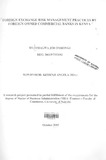| dc.description.abstract | This research endeavoured to achieve three objectives: to ascertain the foreign exchange
risk management practices of foreign owned commercial banks in Kenya, to determine
the extent of foreign exchange risk management by the banks and to rank the
ascertained practices in order of importance. Empirical evidence was extensively used to
link the findings of the study with prescriptions of academic literature. The study focused .
on the head offices of the twelve foreign owned banks in Kenya out of which nine
responded.
The research was an exploratory study carried out as a census survey. Qualitative
primary data was used for the study. Self-administered questionnaires were delivered to
the treasury departments of the banks using 'drop and pick later' technique. Descriptive
statistics were used to analyze the data.
Various inferences were drawn from the findings; the responding banks employed both
conventional and bank-specific foreign exchange risk management practices. Most banks
considered credit/default risk to be the most critical of all financial risks though empirical
evidence shows that foreign exchange risk is the most critical risk for most firms. A
strong majority of the banks did not find the Kenyan currency market to be information
efficient: speculation.~Rd (orec~~ting techniqu~ were extensively used by most of them.
The banks' views on market fundamentals and what constitutes foreign exchange risk
management best practices had a significant bearing on hedging practices adopted.
Regular and systematic appraisal of exchange risk management policies was a common
practice amongst most banks. For most banks, foreign exchange risk management
systems were governed by guidelines set at the head office (highly centralized foreign
exchange risk management systems).
iii
The findings from most banks were similar to empirical evidence but considerably
inconsistent with recommendations of Ilterature. Most banks, regardless of their size,
extensively utilized most of the conventional hedging instruments. Micro hedge approach,
accounting, translation and economic exposure measurement strategies, natural hedging,
risk sharing and diversification were some of the most utilized strategies. Transaction
exposure was rated as the most critical to most banks when compared to translation and
economic exposures. Some hedging practices were considered by most banks to be the
more important than others. These include use of forward contracts and foreign currency
options as hedging instruments, use of matching/natural hedging strategy and preference
of selective hedging strategy instead of hedging all positions immediately. The extent of
foreign exchange risk management by the banks was also gauged: it emerged that most
banks practiced foreign exchange risk management to some extent. | en |

